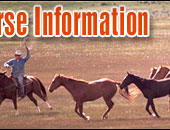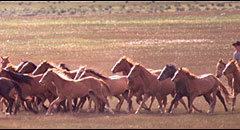 |
   |
|
|
|
You are here: Horses > Horse health > Euthanasia |
Euthanasia — What You Need To Know About Putting a Horse Down
It’s something no horse owner wants to think about. Although
horses have a life expectancy of twenty-five to thirty
years, we are never ready to say goodbye to our old friends.
However, even younger horses can face the prospect of
euthanasia in the event of severe illness or injuries. |
|
|
Unpleasant as the prospect is, having a plan and knowing
what to expect can save both you and your horse unnecessary
suffering.
The decision is left in the owner’s hands. Few veterinarians
will recommend that a horse should be put down. Their job is
not to do that. If your horse becomes very ill, badly hurt,
or is facing emergency surgery, the veterinarian’s role is
to clearly communicate the facts about your horse’s
condition and its odds of survival and recovery. This gives
you the |
information you need to make a decision about what to do
next.
However, most veterinarians will offer euthanasia if there
is no chance that the horse will survive or no other way of
relieving its suffering. Sometimes, they will also discuss
euthanasia if the horse has become a danger to itself, its
owners, or the horses around it. Even in these
circumstances, the final decision rests with the owner.
Also, some veterinarians may refuse to euthanize a horse at
the owner’s request because it has become too old or
arthritic to rid. A horse might not be able to be ridden or
used, but it can still be a good companion animal and live
comfortably if turned out to pasture. If the owner is unable
or unwilling to bear the expense of keeping an unusable
horse, the veterinarian will often weigh the horse’s
prospects of finding another home before refusing or
agreeing to the owner’s request to put it down.
Not only can a veterinarian refuse to put down a horse that
he feels is healthy if unusable, he may also refuse to try
to save a horse if he feels its death is inevitable or that
the treatment will only prolong its suffering. The
veterinarian has the ethical duty and right to make these
decisions, but this can be difficult for an owner to
understand when already upset at the prospect of losing
their valued horse.
Also, if your horse is insured, you should make sure that
you have read and understand the coverage before euthanizing
your animal. Policy provisions and exceptions can add an
additional layer of complexity to an already difficult
decision. Insurance companies want to be informed of health
problems before they reach the point where euthanasia is an
issue. Being familiar with your policy and its terms can
save your horse hours of suffering should an emergency
occur.
While you do not have to delay emergency surgery if you
can’t reach your insurance company, most of them want to
authorize the use of anesthesia. You may have to notify them
after the surgery has already begun. Many will authorize the
veterinary surgeon to use his best judgment in the event the
insurance company cannot be reached, and report to them on
the next business day.
However, this is often not the case with euthanasia. The
insurance company often requires that it approves this
procedure before you can put your horse down. If they feel
that you have not done everything in your power to keep the
insurance company informed, they may refuse to pay on the
policy due to “neglected duties of prior or timely
notification.”
The best-case scenarios for euthanizing a horse both involve
intravenous barbiturate overdose. A horse undergoing surgery
can be given the overdose via the already-established IV if
it becomes clear during the surgery that the horse will not
survive. It is also common for a horse to be euthanized by
intravenous injection outside of surgery. As soon as the
drug is given, the horse loses consciousness, and its pain
is relieved almost instantly. This can be a comforting
thought for the owners.
Beyond these scenarios, things can get a bit more difficult.
If your horse is badly injured or in significant pain it can
be dangerous to attempt to use an injection. If it is in
shock, its circulation may be too impaired to transport the
drug to its brain and heart, and the veins may be difficult
or impossible to locate to administer it. In this situation,
the veterinarian may need to use a .22-caliber pistol to
euthanize the animal.
The gun should be positioned perpendicular to the forehead,
in the center of an imaginary X formed by a line from its
left ear to right eye, and right ear to left eye. If the gun
is properly positioned, death is instantaneous.
The veterinarian will listen for a heartbeat or check the
eye for a reaction by touching it to ensure that the horse
is dead. The eyes of horses are very sensitive, and if any
sensation remains in a severely injured but living horse, it
will be felt in the eye.
If a horse needs to be put down while being transported,
either due to illness or a trailer accident, the owner
should call the state police. They can recommend a local
veterinarian to euthanize the horse, or in emergencies where
the horse is in extreme pain, they can shoot the animal to
end its suffering.
If your horse is injured during competition, check to see if
they have a veterinarian on hand to handle emergencies. Most
large competitions will, but smaller gatherings may not. If
not, ask the competition management to put you in touch with
a local veterinarian. If the vet must euthanize your horse,
he can also advise you on the best way to remove the horse’s
body for burial or disposal.
Being present during your horse’s euthanization is a
personal choice. Veterinarians usually advise against it,
however. Anytime a large animal is put down, things may not
go as planned. This is especially true during stressful
situations, such as those that might necessitate an
emergency euthanasia procedure. The complications which
sometime arise when a horse is put down can be distressing,
dangerous, or unpleasant to watch. Unless you are sure you
can handle this, it is best not to be present.
Unfortunately, deciding to put your horse down and enduring
the process is not the end of it. There is still the matter
of dealing with your horse’s body. If your horse is
euthanized at an equine hospital, they will probably offer
to take care of the disposal for an additional fee.
Otherwise, the arrangements are left up to the owner.
If at all possible, try not to delay burial. Rigor mortis
sets in around two hours after death, making it more
difficult to move the horse’s body and necessitating a much
deeper and wider grave to bury it. Rigor mortis persists for
around a day. Unfortunately, if you have not located someone
nearby with a backhoe before your horse is put down, it
might take this long to hire the backhoe and dig the grave.
It is better to talk with other horse owners in your area
and know the name and phone number of a reliable backhoe
operator before you need him. If you board your horse, the
barn manager may be able to recommend someone to you. Also
check with your local county offices to make sure that there
are no ordinances prohibiting the burial of large animals at
your location. If you know this information in advance, you
can arrange to haul your horse’s body to another location
for disposal. Removal services may also be available, and
your veterinarian probably knows about them if they are.
If you have advance notice that your horse is going to be
put down, have the burial spot picked out and the grave dug
before your veterinarian arrives. It’s important to choose a
spot which does not drain toward a well or water supply for
sanitary purposes. It is safe to bury your horse in a
pasture used by other horses, so long as you are sure the
earth over the burial site is well-packed. However, if your
horse has died from a contagious disease, it’s best to bury
him far from your other horses or, preferably, use a
professional disposal service to properly take care of the
body.
If you are unable to bury your horse, sometimes you will be
able to find a rendering service. Some will even pick up the
body free of charge. County landfills may also allow you to
drop off animal remains, but you must take care of
transporting the body there. Your equine veterinarian is a
reliable source of information as to what is available in
your area, and may have good recommendations for you.
It is also possible to have your horse cremated rather than
buried or hauled off.
If the owner wishes, the horse’s ashes can be placed in a
decorative urn and returned to the owner by mail after the
horse is cremated. Owners should be aware that the cremation
of an average size horse will produce forty to forty-five
pounds of ashes. The owner will also receive a certificate
which states that the ashes are guaranteed to be those of
the owner’s horse.
On average, the cremation of a horse costs around three
hundred dollars. This is roughly equivalent to the cost of
hiring a backhoe to bury the horse.

|
Read the next horse health tips article on Evaluating A Horse's General Condition. |
|
|
|
|
 |
|
|
|
|
|
Horse Education
|
|
|
|
|
Horse Information Topics
|
|
|
|
|
|
|
|
Horse Business Owners
|
| |
Advertise with Us
Have your horse products or services exposed to over 27,000 of our monthly visitors.
|
|
|
|
|
|